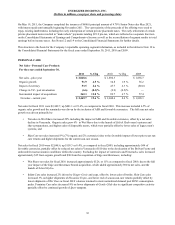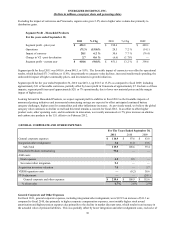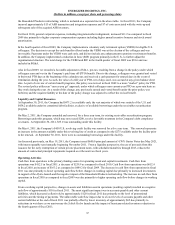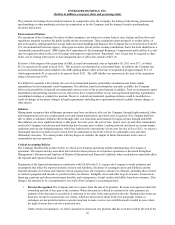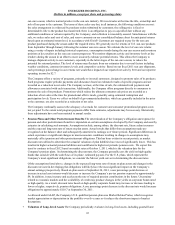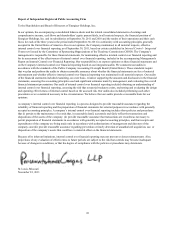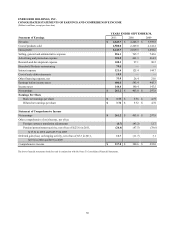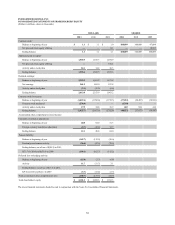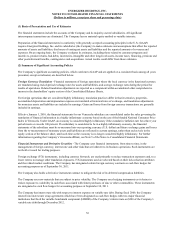Energizer 2011 Annual Report Download - page 54
Download and view the complete annual report
Please find page 54 of the 2011 Energizer annual report below. You can navigate through the pages in the report by either clicking on the pages listed below, or by using the keyword search tool below to find specific information within the annual report.
ENERGIZER HOLDINGS, INC.
(Dollars in millions, except per share and percentage data)
intangible assets, for potential impairment indicators. Judgments regarding the existence of impairment indicators,
including lower than expected cash flows from acquired businesses, are based on legal factors, market conditions and
operational performance. Future events could cause the Company to conclude that impairment indicators exist. The
Company estimates fair value using valuation techniques such as discounted cash flows. This requires management to
make assumptions regarding future income, working capital and discount rates, which would affect the impairment
calculation. See the discussion on “Acquisitions” included later in this section for further information.
• Income Taxes Our annual tax rate is determined based on our income, statutory tax rates and the tax impacts of items
treated differently for tax purposes than for financial reporting purposes. Tax law requires certain items be included in
the tax return at different times than the items are reflected in the financial statements. Some of these differences are
permanent, such as expenses that are not deductible in our tax return, and some differences are temporary, reversing
over time, such as depreciation expense. These temporary differences create deferred tax assets and liabilities.
Deferred tax assets generally represent the tax effect of items that can be used as a tax deduction or credit in future
years for which we have already recorded the tax benefit in our income statement. Deferred tax liabilities generally
represent tax expense recognized in our financial statements for which payment has been deferred, the tax effect of
expenditures for which a deduction has already been taken in our tax return but has not yet been recognized in our
financial statements or assets recorded at fair value in business combinations for which there was no corresponding tax
basis adjustment.
We regularly repatriate a portion of current year earnings from select non U.S. subsidiaries. Generally, these non-U.S.
subsidiaries are in tax jurisdictions with effective tax rates that do not result in materially higher U.S. tax provisions
related to the repatriated earnings. No provision is made for additional taxes on undistributed earnings of foreign
affiliates that are intended and planned to be indefinitely invested in the affiliate. We intend to, and have plans to,
reinvest these earnings indefinitely in our foreign subsidiaries to fund local operations, fund pension and other post
retirement obligations and fund capital projects.
The Company estimates income taxes and the income tax rate in each jurisdiction that it operates. This involves
estimating taxable earnings, specific taxable and deductible items, the likelihood of generating sufficient future taxable
income to utilize deferred tax assets, the portion of the income of foreign subsidiaries that is expected to be remitted to
the U.S. and be taxable and possible exposures related to future tax audits. Deferred tax assets are evaluated on a
subsidiary by subsidiary basis to ensure that the asset will be realized. Valuation allowances are established when the
realization is not deemed to be more likely than not. Future performance is monitored, and when objectively
measurable operating trends change, adjustments are made to the valuation allowances accordingly. To the extent the
estimates described above change, adjustments to income taxes are made in the period in which the estimate is
changed.
The Company operates in multiple jurisdictions with complex tax and regulatory environments, which are subject to
differing interpretations by the taxpayer and the taxing authorities. At times, we may take positions that management
believes are supportable, but are potentially subject to successful challenges by the appropriate taxing authority. The
Company evaluates its tax positions and establishes liabilities in accordance with guidance governing accounting for
uncertainty in income taxes. The Company reviews these tax uncertainties in light of the changing facts and
circumstances, such as the progress of tax audits, and adjusts them accordingly.
• Acquisitions The Company uses the purchase method, which requires the allocation of the cost of an acquired
business to the assets acquired and liabilities assumed based on their estimated fair values at the date of acquisition.
The excess value of the cost of an acquired business over the fair value of the assets acquired and liabilities assumed is
recognized as goodwill. The valuation of the acquired assets and liabilities will impact the determination of future
operating results. The Company uses a variety of information sources to determine the value of acquired assets and
liabilities including: third-party appraisers for the values and lives of property, identifiable intangibles and inventories;
actuaries for defined benefit retirement plans; and legal counsel or other experts to assess the obligations associated
with legal, environmental or other claims.
Significant judgment is required in estimating the fair value of intangible assets and in assigning their respective
useful lives. The fair value estimates are based on historical available information and on future expectations and
assumptions deemed reasonable by management, but are inherently uncertain. Determining the useful life of an
intangible asset also requires judgment. Certain brand intangibles are expected to have indefinite lives based on their
history and our plans to continue to support and build the acquired brands. Other intangible assets are expected to have
determinable useful lives. Our assessment of intangible assets that have an indefinite life and those that have a
determinable life is based on a number of factors including the competitive environment, market share, brand history,
44


